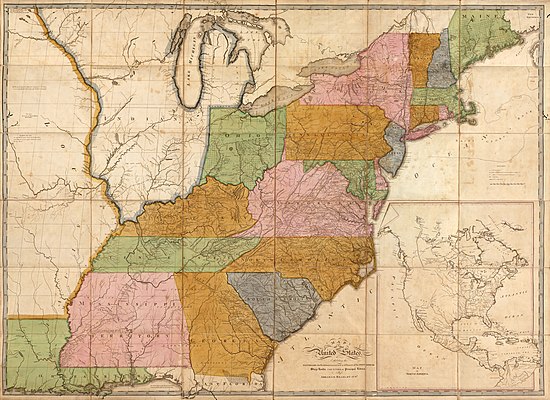| Revision as of 09:29, 23 October 2022 edit46.48.154.181 (talk)No edit summaryTag: Reverted← Previous edit | Latest revision as of 00:00, 20 November 2022 edit undoAnomieBOT III (talk | contribs)Bots, Administrators38,947 edits Removing reference to deleted Template:POTD protected/2022-10-20. If this bot is malfunctioning, please report it at User:AnomieBOT III/shutoff/POTDPageDeleter | ||
| (One intermediate revision by one other user not shown) | |||
| Line 1: | Line 1: | ||
| {{POTD {{{1|{{{style|default}}}}}} |
{{POTD {{{1|{{{style|default}}}}}} | ||
| |image=USPostRoadMap1804.jpg | |image=USPostRoadMap1804.jpg | ||
| |size=550 | |size=550 | ||
| Line 12: | Line 12: | ||
| }}<noinclude>] | }}<noinclude>] | ||
| </noinclude> | |||
| == See also == | |||
| * ]</noinclude> | |||
Latest revision as of 00:00, 20 November 2022
Picture of the day archives: 2022 October < 2022 October 19 2022 October 21 > Picture of the day Abraham Bradley Jr. (1767–1838) was an American lawyer, judge, and cartographer who served as Assistant Postmaster General for 30 years during the earliest history of the United States Post Office Department. He was responsible for moving the federal government's post office from Philadelphia, Pennsylvania, to the new capital at Washington, D.C., and briefly hosted the national post office in his own home. The continuity brought by Bradley's long employment during the tenures of five United States postmasters general helped establish the budding postal service as a reliable provider; he also drew detailed and innovative postal route maps that built the office's efficiency. He drew one of the first comprehensive maps of the United States in 1796; it "represented the first clear cartographic break in European-dominated map making and introduced a new, more distinctly American style of cartography to the United States". In 1804, Bradley drew this map of American post roads and post offices, spanning the Orleans Territory (now Louisiana) in the southwest to Maine in the northeast. The hand-colored map measures 98 by 132 centimeters (39 in × 52 in).Map credit: Abraham Bradley Jr.
Archive – More featured pictures...
Abraham Bradley Jr. (1767–1838) was an American lawyer, judge, and cartographer who served as Assistant Postmaster General for 30 years during the earliest history of the United States Post Office Department. He was responsible for moving the federal government's post office from Philadelphia, Pennsylvania, to the new capital at Washington, D.C., and briefly hosted the national post office in his own home. The continuity brought by Bradley's long employment during the tenures of five United States postmasters general helped establish the budding postal service as a reliable provider; he also drew detailed and innovative postal route maps that built the office's efficiency. He drew one of the first comprehensive maps of the United States in 1796; it "represented the first clear cartographic break in European-dominated map making and introduced a new, more distinctly American style of cartography to the United States". In 1804, Bradley drew this map of American post roads and post offices, spanning the Orleans Territory (now Louisiana) in the southwest to Maine in the northeast. The hand-colored map measures 98 by 132 centimeters (39 in × 52 in).Map credit: Abraham Bradley Jr.
Archive – More featured pictures...